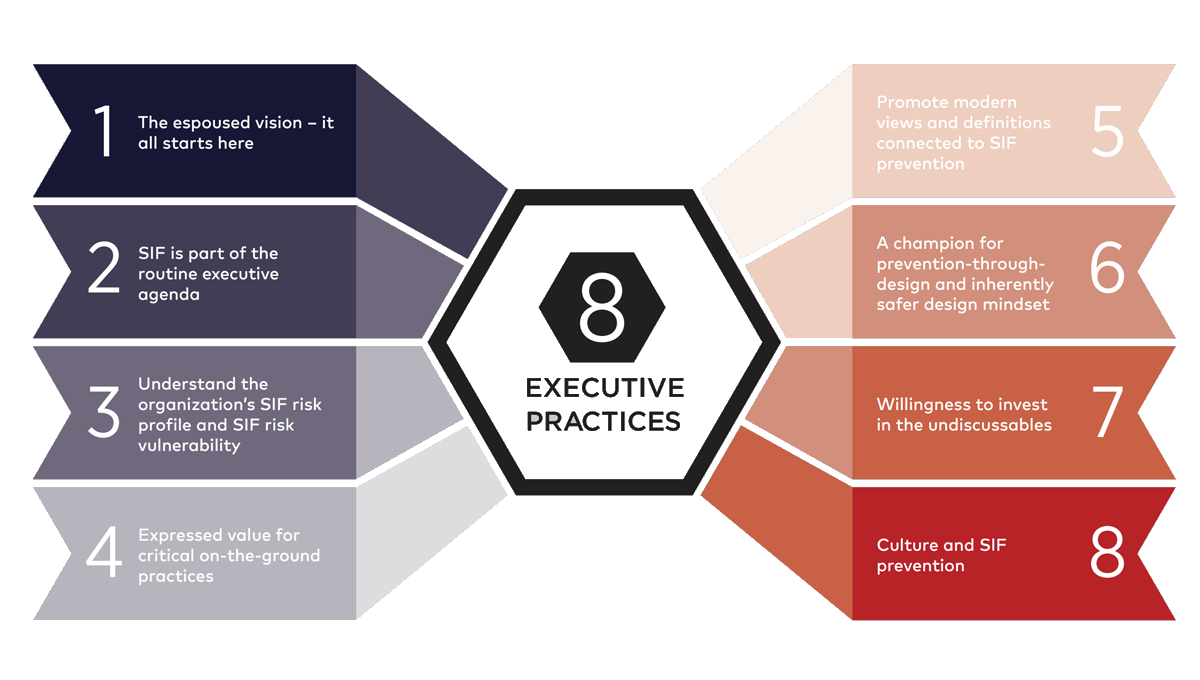Executive Sponsorship Is Critical to SIF Prevention - Part 3 of 3
Why Executive Sponsorship is Critical to SIF Prevention
These days, the list of executive accountabilities is formidable, and SIF prevention can be easily lost in the shuffle. CEOs accept SIF prevention as a personal, moral, and ethical responsibility—making it part of their value system and therefore a consistent element of their operational decision-making. They recognise the need to implement protective policies and procedures that go well beyond any regulatory requirements, and they rarely ask for any form of calculated return on investment when making decisions favourable to SIF risk control. When executives live by the tenets described in this white paper, they send powerful signals to their organisation about the importance of SIF risk control.

|
This is the third of a three-part series on the dss+ approach to Serious Injury and Fatality (SIF) Prevention. The first and second papers focused on quantifying the organization’s vulnerability to SIF risk and sustaining organizational control of SIF risk. This paper concentrates on why executive sponsorship, governance, and involvement are essential to the successful performance of any organisational SIF risk control initiative. |
SIF Risk Control
Today’s modern executives have a lot on their plates. Pleasing investors, meeting ESG commitments, addressing social issues, generating revenue, and enhancing the company's reputation — just to name a few! Moreover, preventing serious injuries and fatalities (SIF) is emerging to become a common thread throughout the entire executive agenda.
In our global work with companies that deliver successful operational risk management (ORM) and SIF prevention results, we’ve asked, “What’s at the core of a high-performing SIF risk management process?” The answer? “Executive sponsorship and engagement.” What does this look like, and why is this important? The list of executive accountabilities is formidable, and SIF prevention can be easily lost in the shuffle.
Today’s chief executive accepts SIF prevention as a personal, moral, and ethical responsibility.
Today’s chief executive accepts SIF prevention as a personal, moral, and ethical responsibility — making it part of their value system and therefore a consistent element of their operational decision-making. These executives recognize the need to implement protective policies and procedures that go well beyond any regulatory requirements, and they rarely ask for any form of calculated return on investment when making decisions favourable to SIF risk control. They frequently “get off the Yellow Brick Road,” go places in the work environment where other leaders don’t want them to go, and ask the right questions about SIF.
Executive Practices
When leaders demonstrate the aforementioned behaviours, they send clear signals within their organisation that SIF Prevention is a strategic operational issue that must be treated as such. Let’s take a closer look at several key executive practices demonstrating strong sponsorship of SIF risk control.

-
The espoused vision - it all starts here
The chief executive must establish a clear vision showing exactly what they want to accomplish in SIF prevention. The vision is a central element, reflective of who they are as an executive and what they stand for. It goes further by spotlighting what type of work environment the company will provide and what the company will be known for in its quest for SIF prevention. Best-in-class visions will transcend any reference to compliance with regulatory requirements. These executives know that mere compliance is guaranteed to deliver mediocre safety performance, and fatal accidents will still occur if they don’t aspire to something better. Employees, board members, investors, customers, and the local community expect the absolute best and will accept nothing less. The organization’s vision for SIF prevention should leave no doubt about the value the chief executive places on SIF prevention.
-
SIF is part of the routine executive agenda
Elements of SIF are routinely discussed in executive meetings. These elements are designed to explore the role of executives in influencing SIF risk control. For example, in any particular business unit:
- What types of near hits with SIF potential were reported?
- During your last field visit, did you validate the presence and effectiveness of SIF critical controls?
- Did you participate in any job safety briefs, did they accurately anticipate any SIF risks, and did you ensure that controls were in place and functioning before allowing the work to proceed?
SIF metrics and dashboards are used to guide the conversation. Executives have supported the evidence-based development of a critical few metrics to inform them on the status of SIF risk control. Several levels of metrics are found on the executive SIF dashboard. For example:
- Leading indicators that are accurate predictors of SIF risk control (e.g., the percentage of critical controls present and performing on the ground).
- Indicators to monitor the health of the SIF prevention system (e.g., reporting of events and determination of SIF risk potential).
- Outcome metrics to speak the truth about the occurrence of actual SIF events (e.g., the number of actual life-threatening, life-altering, and life-ending events).
-
Understand the organization’s SIF risk profile and SIF risk vulnerability
Executives with high-performing SIF risk control programs have successfully quantified their levels of SIF risk. They understand their vulnerability to a SIF event because they no longer rely on lagging indicators such as recordable injury rate, lost-time injury rate, or workers’ compensation costs to draw misleading conclusions about their level of SIF risk control. Instead, they have established a more proactive and reliable set of indicators to provide an accurate view of SIF vulnerability. For example, modern executives can now rely on:
- Quantified views of SIF risks, based on data and evidence.
- Quantified views of the presence and performance of critical controls, reflecting on-the-ground observation, data collection, and analysis.
- Use of digital technology (like Management Initiatives for Risk Analysis/MIRA™) to provide significant insight on SIF risk, vulnerability to SIF risk, and monitoring of control activities.
-
Expressed value for critical on-the-ground practices
Executives at leading organisations are committed to the development and sustainment of an on-the-ground SIF risk-aware culture. Hallmarks of this culture include:
- Encouraging and supporting near-hit reporting and use of stop-work authority. Every level of management, and all worker peer groups, agree reporting near hits and using pause-work are highly desirable behaviours that promote SIF prevention and exceptional teamwork. Sometimes, these behaviours are the last line of defence when other SIF protections have failed, and workers on the ground need to know that management is 100 percent supportive of these behaviours and will also say thank you when performed by any worker. This support starts at the very top of the organisation.
- Leading effective pre-job safety briefings. Before each job begins, the crew must perform a safety briefing to identify the SIF risks and controls they expect to encounter in the job ahead. The best briefings are interactive, collaborative, and involve everyone. They accurately predict the SIF risk and ensure that the critical controls are available and ready before the job is allowed to proceed. Diligent execution of a SIF-oriented briefing takes time and commitment. Stopping a job and conducting a new safety briefing when risk changes, or when additional exposures are introduced, is another best practice executives are aware of. After-action reviews upon completion of a job (lessons learned, prep the next crew for success) are another best practice. Executives at the top of the company are responsible for communicating their belief that these practices are the right thing to do and are fully supported all the way through the organization.
- Conducting validation of SIF protection controls on the ground. Each task with SIF risk must have a set of high-performing controls available to protect workers in these work situations. These controls must be periodically validated as present and performed through a formal observation and an interview process. Data should be collected to advise leadership on any patterns of underperforming critical controls.

Executives at leading organisations are committed to the development and sustainment of an on-the-ground SIF risk-aware culture.
Data is also collected to provide executives with a quantified level of assurance that SIF protective controls are in place and performing as intended. This process requires time and data technology systems supported by the executive team.
-
Promote modern views and definitions connected to SIF prevention
Lifesaving rule processes must be truly protective and 100-per cent enabled from the front-line worker’s perspective. Effective executives develop modern views on this subject through continuous education and learning, reading the research, participating in roundtables, and studying the subject from the practical perspective of a field worker
A zero-tolerance policy is a normal element of any SIF Prevention program. However, the definition and application of zero tolerance must be deliberated at the executive level before extending into the workplace. What do you have zero tolerance for: zero tolerance for any deviation of any kind for any life-critical rule (where the lone employee is held accountable)? Or, is it zero tolerance for allowing a SIF risk situation to remain uncontrolled (where leadership is accountable)? This conversation must start at the top of the organization. The definitions and decision-making around zero tolerance will have far-reaching consequences. Ultimately, these conversations will determine if leadership is instilling a culture of fear or building a culture of commitment; creating a punishing organization or a learning organization.
Variance control (and exception management) defines how easy is it for others to apply their own interpretations to a policy/procedure. How easy is it for supervisors to grant exemptions to established policy? How easy is it for anyone to grant themselves a personal variance for whatever reason makes sense to them? Executives must draw the line and establish clear boundaries for limiting authority in this area so that normalization of deviation does not creep into standard work practices.
The modern executive points the organization toward making the workplace safer and changing the way work gets done, rather than focusing on “fixing the workers.”
-
A champion for prevention-through-design and inherently safer design mindset
The executive office is responsible for pushing the organization for diligence in causal evaluations and looking for multiple latent cultures, leadership, and systems issues (beyond proximate human causes and equipment/machine failures). It doesn’t make any difference which formal methodology is adopted: diligence and consistent application is the key. Trained and supported evaluators take the time to perform this function well.
Executives are curious about the development of effective corrective and preventive actions (CAPAs) oriented toward the application of the safety hierarchy of controls. They continuously promote the view that elimination, substitution, and engineering controls are much more protective than exclusive reliance on human behaviour (training, following procedures, wearing PPE).
When performed well, effective accident investigations can provide powerful platforms for launching “prevention through design” and “inherently safer design” mindsets in the organization. The modern executive points the organization toward making the workplace safer and changing the way work gets done, rather than focusing on “fixing the workers.”
-
Willingness to invest in the undiscussable
In many organisations, ‘grey areas’ exist that can be easily overlooked. Executives may feel that others in the company are dealing with these issues and would prefer not to discuss them. These issues can be significant contributors to SIF accidents and are certainly deserving of executive attention. By showing interest, executives convey to the organization the importance of investing time in understanding and mitigating these risks. Three significant areas common to many organizations include:
-
Over-the-road motor vehicle incident (MVI) SIF risk
Motor vehicle incidents are consistently the #1 cause of work-related deaths in nearly every country around the world, accounting for 24 per cent of all work-related fatalities in the US. Reliance on local, state, federal, and insurance authorities to manage this risk is insufficient. Executives decide whether their company will take a proactive and preventive stance on this issue and build a process specifically designed for MVI SIF prevention, or follow voluntary guidance standards such as ANSI Z15.1 Safe Practices for Motor Vehicle Operations
-
Contractor selection, oversight, and retention
Contractors account for nearly 20 per cent of all work-related fatalities in the US. We are using contractors at an increasing rate every year, and we assign them much of the SIF-risk-intensive work that needs to be performed.
- Contractor-qualifying criteria must reinforce your company’s vision, culture, and SIF prevention practices. Great contractor partners are also aligned with the company’s point of view for SIF prevention. Executives should be involved in establishing and approving the selection criteria and ensuring contractor alignment with the company’s espoused vision for SIF prevention. Executives should meet with contractor executives to establish clear lines of understanding on expectations and accountabilities.
- Executives are also interested in seeing the data from periodic on-the-ground validations of critical control performance, and they want to see evidence of healthy reporting and causal evaluation processes. They ask questions about these topics and carry this information into field-level conversations with work crews.
- Executives are willing to invest in long-term partnerships with worthy contractors. They see the value in these relationships, not only from a business growth perspective but also from an aligned focus on SIF prevention. At times, this may be an opportunity for executives to coach sourcing professionals in the value of preserving high-value contractor relationships over project budgets.
By showing interest, executives convey to the organization the importance of investing time in understanding and mitigating risk.
-
Understanding just culture and the science of human behavior
Executives are responsible for setting the tone in regard to how people are treated during investigations of SIF incidents. They understand that people are not robots, not programmed, and are not cogs in a machine. Leaders create a just culture when their reactions to incidents are measured, calming, and search for facts. People are treated with respect because we know that we all make mistakes and that decision-making is a complex activity involving many external and internal influences. Great executives understand they must sponsor a workplace that is error-tolerant. Multiple layers of defence are present so that one human error cannot lead to a catastrophic outcome. Investigations lead to organizational learning and improved mitigation, not punitive actions that fail to prevent the next SIF event. Executives invest time in learning about the applied behaviour analysis model (antecedent/ behaviour/consequence) and various neuroscience models that affect human performance (fast brain/slow brain, memory, fatigue, past experiences, affective psychology, etc.).
-
-
Culture and SIF prevention
Resilient companies and leaders take a holistic view of SIF and see the risks and solutions as integrated into the entire operational framework. In other words, SIF prevention is unlikely to be successful if it is buried inside one of your company’s risk management silos (Safety Department, EHS Department, Regulatory Affairs, HR, Legal). It needs to be threaded throughout the entire value chain, and this requires executive attention and sponsorship.
When executives set the stage with the right vision for SIF prevention, and follow that with consistent demonstration of best practices, we can see the results in culture and performance.
Executives envision, build, drive, and sustain culture — and the culture must contain a philosophy of SIF risk management integrated into everything you do.
When executives set the stage with the right vision for SIF prevention, and follow that with consistent demonstration of best practices, we can see the results in culture and performance.
When the organisational culture is oriented toward SIF prevention, performance will be manifested at every level in at least the following ways:
-
At the front-line, individual worker/team level
- We consistently follow procedures that control the risk of life-altering injuries.
- Before we execute any task that has the potential for SIF, we conduct an effective pre-job safety tailboard.
-
At the front-line, supervisor level
- When anyone on my crew stops a job because an important safety step was missing, I will always say “Thank you, that was the right thing to do”.
- I will always know which tasks have the risk of life-altering consequences, and I will provide protection for my people.
- My teams conduct effective job safety briefings. As a team, we know the SIF risks and how to mitigate them.
- I see SIF hazards/risks in the workplace and so do my team members.
- I can lead an effective Incident Investigation that results in CAPAs that are at the upper end of the hierarchy of controls.
-
At the company management level
- Protecting workers from life-altering situations is the most important thing to me.
- I will always be responsive to any concern raised related to the potential risk of life-altering injuries.
- I will make sure the company is always committed to controlling SIF risk.
- I will always be interested in what else we could be doing to further reduce or eliminate the risk for SIF.
-
Summary
When executives live by the tenets described in this paper, they send powerful signals to their organization about the importance of SIF risk control. Executives at the top of high-performing SIF prevention programs accept personal ownership of this initiative and resist delegating this responsibility to others. Their passion for the subject is evident, the time and resources committed are visible to many, and it is clear to everyone where they stand on SIF prevention.
|
Final questions to consider How would your front-line workers respond to the question, “Where does your chief executive stand on the subject of SIF prevention?”
|